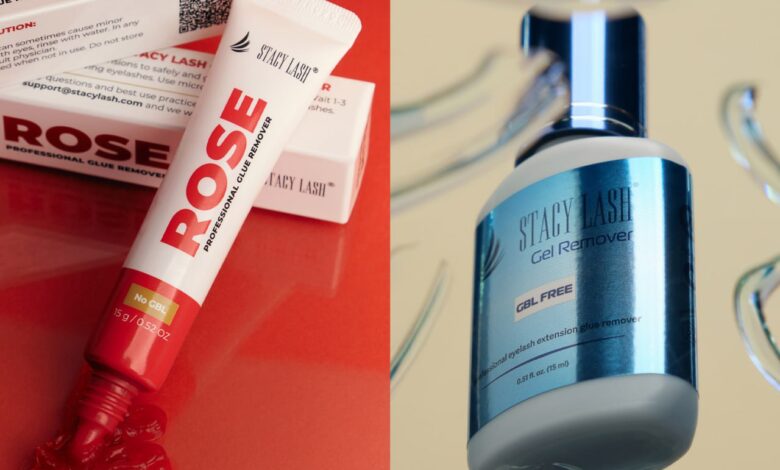Cream, Gel, or Liquid: Which Lash Remover Should You Use?

Lash removal is just as important as lash application. Whether correcting a poor set, preparing for a new style, or addressing client sensitivity, using the right lash remover is crucial to ensure the natural lashes remain healthy and intact. But with multiple options — cream, gel, and liquid — how should a lash artist decide which eyelash extension remover is best for the job?
Let’s break down the types of removers, selection tips, lash removal technique best practices, and post-removal care, so you’re fully equipped with the knowledge and lash artist tools to deliver professional, safe results every time.
Overview of Types of Lash Removers and How They Work
Lash glue remover is designed to break down the cyanoacrylate bond in lash adhesives, allowing extensions to slip off the natural lash without pulling or damaging it. There are three main types of removers:
Cream Remover:
Thick and controllable, cream removers stay exactly where you place them. They work by slowly dissolving the glue, typically over 5–10 minutes, and are known for being beginner-friendly. Because of their non-drip formula, they’re ideal for full set removals or delicate touch-ups near the lash line.
Gel Remover:
Slightly thinner than cream, gel removers are transparent and allow you to see the lashes underneath while working. They have a faster application time to creams but require more precision, as they can slide if over-applied. Gel removers are often used for partial removals or isolated extension removal.
Liquid Remover:
This is the fastest-acting but also the riskiest formula. Liquid removers are thin, runny, and typically used for advanced-level spot removals where time is critical. Because they can easily seep into the eye if not handled carefully, they require advanced skill and control.
Choosing Between Cream, Gel, and Liquid Removers
Selecting the right eyelash extension remover depends on several factors:
Type of removal: For a full removal, cream is often preferred; for partial removals, gels offer precision; and for quick fixes or emergency repairs, a skilled artist might reach for liquid.
Lash artist skill level: Beginners and intermediate lash artists should stick to cream or gel removers, as they offer more control. Liquids are best left to experienced professionals due to the risk of eye irritation or injury.
Timing and efficiency: If time is a concern and you are confident in your lash removal technique, gels can strike the right balance between speed and safety.
Step-by-Step Safe Removal Process to Protect Natural Lashes
Regardless of the remover you choose, follow these essential steps:
Prepare your station: Have all your lash artist tools ready — remover, micro brushes, eye pads, tweezers, and cleanser. Ensure the client is lying comfortably with eyes closed.
Apply under-eye pads: Protect the lower lashes and skin with hydrogel pads or medical tape to prevent remover contact.
Apply the remover: Using a micro brush, apply a small amount of remover precisely onto the base of the extensions, avoiding skin contact.
Wait and monitor: Allow the remover to work for the instructed time, usually 5–10 minutes, depending on the formula and glue type. Do not rush — patience protects the natural lashes.
Gently slide off extensions: Using two micro brushes or tweezers, gently roll or slide the extensions off. Never pull or force them.
Cleanse thoroughly: Remove all residue with a lash cleanser and rinse with saline or water to ensure no remover is left behind.
When and Why Clients Might Request a Removal
Clients request removals for several reasons, and as a professional, it’s important to understand their motivations:
Allergic reaction or irritation: Sometimes, a client may develop sensitivity or allergy to lash adhesives. Immediate removal minimizes discomfort.
Poor application by another artist: Clients may come to you for a removal if they are unhappy with the look or feel of another salon’s work.
Style change or break period: Some clients want to switch to a different lash style or take a break to let their natural lashes rest.
End of lash cycle: When extensions become sparse after several weeks, some clients prefer a full removal and fresh application instead of infills.
Common Mistakes to Avoid During the Procedure
Even experienced artists can make missteps when it comes to lash removal. Here are key mistakes to avoid:
Using too much remover: Overloading product increases the risk of it seeping into the eyes, especially with gels and liquids. Apply just enough to coat the glue bonds.
Rushing the process: Impatience leads to forced removal, which can damage or break natural lashes. Always wait the recommended time.
Skipping patch tests on new clients: Even glues labeled as “gentle” can cause reactions. For new clients, perform a patch test before full application.
Not cleansing thoroughly afterward: Leftover remover can irritate the skin or affect retention on the next application.
Post-Removal Lash Care and Reapplication Recommendations
After a removal, it’s essential to guide clients on aftercare and preparation for future appointments:
Conditioning: Recommend a nourishing lash serum or conditioner to strengthen natural lashes, especially if they feel dry or brittle post-removal.
Waiting period: For clients recovering from irritation or damage, advise a rest period before reapplying extensions. This allows the lashes and skin to recover.
Proper cleansing: Teach clients to cleanse the lash line gently with oil-free products to maintain lash health.
Next appointment planning: If the removal was done for style change or correction, plan a reapplication after a few days, ensuring the natural lashes are clean and ready for a fresh set.
Conclusion
Choosing the right lash remover is not just about product preference — it’s about safety, precision, and professionalism. As a lash artist, knowing when to use cream, gel, or liquid removers will elevate your lash removal technique and protect your clients’ natural lashes.
Stocking high-quality removers and tools from a trusted lash supply store ensures you deliver the best results and maintain client trust. Remember, removal is not an afterthought — it’s a key part of your service portfolio, and mastering it sets you apart as a true professional in the lash industry.



